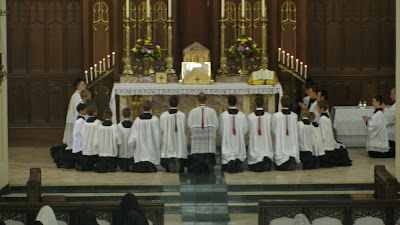The Institution of the Feast of the Sacred Heart was a result of the appearances of our Lord to St. Margaret Mary Alacoque in 1675. St. Margaret Mary suffered contempt from many people who refused to believe the authenticity of the visions. In these appearances, Our Lord told her twelve graces that He would give to anyone devoted to His Sacred Heart. She died in 1690 and it was not until 1856 that the Feast of the Sacred Heart of Jesus was placed officially on the Church calendar. However, devotion to the Sacred Heart of Jesus dates back even to the Middle Ages.
In 1693, three years after the death of St. Margaret Mary, the Holy See imparted indulgences to the Confraternities of the Sacred Heart, and in 1697 granted the feast to the Visitandines with the Mass of the Five Wounds, but refused a feast common to all, with special Mass and Office. The devotion spread, particularly in religious communities. The Marseille plague in 1720 furnished perhaps the first occasion for a solemn consecration and public worship outside of religious communities. Other cities of southern Europe followed the example of Marseille. In 1726 Rome was again asked for a feast with a Mass and Office of its own; this was refused in 1729, but granted in 1765. In that year, at the request of the queen, the feast was received quasi-officially by the episcopate of France.
In 1856, at the urgent entreaties of the French bishops, Pope Pius IX extended the Feast of the Sacred Heart to the Latin Church under the rite of double major. In 1889 it was raised by the Latin Church to the double rite of first class. In 1928, Pope Pius XI raised the feast to the highest rank, Double of the First Class, and added an octave; the 1955 reforms of the general Roman calendar suppressed this octave and removed most other octaves. On November 9, 1921, Pope Benedict XV established the Feast of the Eucharistic Heart of Jesus on the Thursday within the Octave of the Sacred Heart.
Up until 1955 but after the time of Pope St. Pius X, Octaves were arranged in the following hierarchical order:
Up until 1955 but after the time of Pope St. Pius X, Octaves were arranged in the following hierarchical order:
- Privileged Octaves
- Privileged Octaves of the First Order
- Octave of Easter
- Octave of Pentecost
- Privileged Octaves of the Second Order
- Octave of Epiphany
- Octave of Corpus Christi
- Privileged Octaves of the Third Order
- Octave of Christmas
- Octave of the Ascension
- Octave of the Sacred Heart
- Privileged Octaves of the First Order
- Common Octaves
- Octave of the Immaculate Conception of the BVM
- Octave of the Solemnity of St. Joseph
- Octave of the Nativity of St. John the Baptist
- Octave of Saints Peter and Paul
- Octave of All Saints
- Octave of the Assumption of the BVM
- Simple Octaves
- Octave of St. Stephen
- Octave of St. John the Apostle
- Octave of the Holy Innocents

















